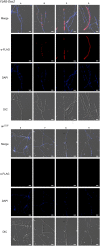The Daisho Peptides Mediate Drosophila Defense Against a Subset of Filamentous Fungi
- PMID: 32038657
- PMCID: PMC6989431
- DOI: 10.3389/fimmu.2020.00009
The Daisho Peptides Mediate Drosophila Defense Against a Subset of Filamentous Fungi
Abstract
Fungal infections, widespread throughout the world, affect a broad range of life forms, including agriculturally relevant plants, humans, and insects. In defending against fungal infections, the fruit fly Drosophila melanogaster employs the Toll pathway to induce a large number of immune peptides. Some have been investigated, such as the antimicrobial peptides (AMPs) and Bomanins (Boms); many, however, remain uncharacterized. Here, we examine the role in innate immunity of two related peptides, Daisho1 and Daisho2 (formerly IM4 and IM14, respectively), found in hemolymph following Toll pathway activation. By generating a CRISPR/Cas9 knockout of both genes, Δdaisho, we find that the Daisho peptides are required for defense against a subset of filamentous fungi, including Fusarium oxysporum, but not other Toll-inducible pathogens, such as Enterococcus faecalis and Candida glabrata. Analysis of null alleles and transgenes revealed that the two daisho genes are each required for defense, although their functions partially overlap. Generating and assaying a genomic epitope-tagged Daisho2 construct, we detected interaction in vitro of Daisho2 peptide in hemolymph with the hyphae of F. oxysporum. Together, these results identify the Daisho peptides as a new class of innate immune effectors with humoral activity against a select set of filamentous fungi.
Keywords: Drosophila; antifungal; humoral; innate immunity; toll.
Copyright © 2020 Cohen, Lindsay, Xu, Lin and Wasserman.
Figures







References
Publication types
MeSH terms
Substances
Supplementary concepts
Grants and funding
LinkOut - more resources
Full Text Sources
Molecular Biology Databases
Research Materials

